/
Not as surprising when you see the FAA’s restrictions.
:format(webp)/cdn.vox-cdn.com/uploads/chorus_asset/file/24375554/drone_2_s.jpg)
It’s been nearly a decade since Amazon’s Jeff Bezos promised us delivery drones, but they aren’t off to a particularly impressive start. Roughly a month after Amazon Prime Air made its first deliveries in California and Texas, it’d served fewer than 10 households — and it’s already laid off more than half the employees at those locations.
That’s according to a pair of new reports at The Information and Business Insider, and Amazon isn’t denying it. Amazon spokesperson Maria Boschetti didn’t contest those numbers in an email to The Verge when we asked. But she also said that Prime Air is actually working to expand drone deliveries in both California and Texas, with the FAA’s approval.
And there may be a very good reason why Amazon doesn’t have a lot of customers for drone deliveries quite yet, as The Information points out: Amazon’s drone isn’t allowed to fly over roads by itself.
To cross the road while still abiding by FAA rules, Amazon employees had to act as spotters to make sure no vehicles were coming when the drone needed to fly across the street, a plan the FAA approved.
Seems ridiculous, right? Amazon’s drone is effectively a five-year-old who needs to hold hands to cross the street. A drone designed to replace humans needs humans to go places.
But before you decide Amazon’s drone isn’t capable, before you conclude that the FAA is halting progress in its tracks — either or both of which might be true! — I suggest you actually read the FAA’s decision that made things this way. I’ve embedded it at the bottom of this story.
If you’ve never dug into an FAA drone filing before, you might not be aware: the FAA doesn’t exactly hand out licenses to operate autonomous drones and drone delivery services. It creates specific exemptions to the United States’ strict airspace regulations, each with a long list of conditions that companies must follow.
Until last November, Amazon couldn’t even fly its drones outside of “sparsely populated areas,” couldn’t fly over buildings or within 100 feet of a building, and had to stick to flying over property under Amazon’s total control. The FAA required Amazon’s drone pilots to have the kind of private pilot license that’d let you fly a plane, not just a drone. If I’m reading correctly, every flight needed as many as six human beings, including observers and ground station operators.
That seems to have been wise. There were five crashes in four months at Amazon’s testing facilities in Oregon, and one crash ignited a 25-acre brush fire. The drone weighs nearly 90 pounds.
But those rules were during the experimental stage, and Amazon successfully argued last November that its experience and its new, safer and more autonomous MK27-2 drone didn’t need as many humans or safeguards. Among other things, the FAA cited its “enhanced perception system that allows for detection of people or obstacles below the UA during delivery or landing,” its auto-abort feature, remote alerts, and the fact that it can fly even if one of its six motors fails as reasons to nix those specific restrictions and more.
But not all of them, not by a long shot. Here are just some of the ground rules that still exist:
i. Operations over people are prohibited, unless otherwise approved by the Administrator;
ii. Overflight of power plants is prohibited;
iii. Overflight of schools during times of operation (e.g., elementary, middle, high, preschool and daycare facilities) is prohibited;
iv. Operations over or within 250 ft. laterally of moving vehicles are prohibited, unless otherwise approved by the Administrator
v. Overflight of any area deemed high risk by the Operator during the flight route design process are prohibited;
vi. Sustained flight within 250 ft. laterally of roadways is prohibited, and transitions over roadways is prohibited, unless otherwise approved by the Administrator;
vii. The UA must remain at least 100 ft. laterally from any person during all phases of flight, unless otherwise approved by the Administrator.
You’ll notice that Amazon’s drone still can’t cross a road by itself, and can’t come near or fly over people. That means Amazon’s customers can’t stand in their own backyards when the package gets dropped — unless their backyards are bigger than my house — and the FAA states that Amazon has to explicitly warn customers about that when they sign up.
In addition, both its California and Texas operations were limited to flights within just 3-4 miles of their drone launch sites. That’ll limit the number of potential customers.
Now, however, Amazon no longer needs nearly as many people for each flight, and the FAA is no longer requiring those employees to have the same flight or medical training — so it’s not surprising that Amazon would lay off many workers now it’s made them expendable.
“The recent staffing reductions do not impact our plans to deliver in these locations,” Amazon spokesperson Maria Boschetti tells The Verge. “We remain committed to our delivery operations in Lockeford and College Station and will continue to offer a safe and exceptional drone delivery service to our customers in both locations. We’ll gradually expand deliveries to more customers in those areas over time.”
She says the FAA approved flights to more customers in Lockeford, California and College Station, Texas just last week, and that Amazon is continuing to work on its next-generation drone, the MK30.
You can read the FAA’s revised requirements for Amazon’s MK27-2 delivery drone (and the reasons for its decisions) in the full document below.
